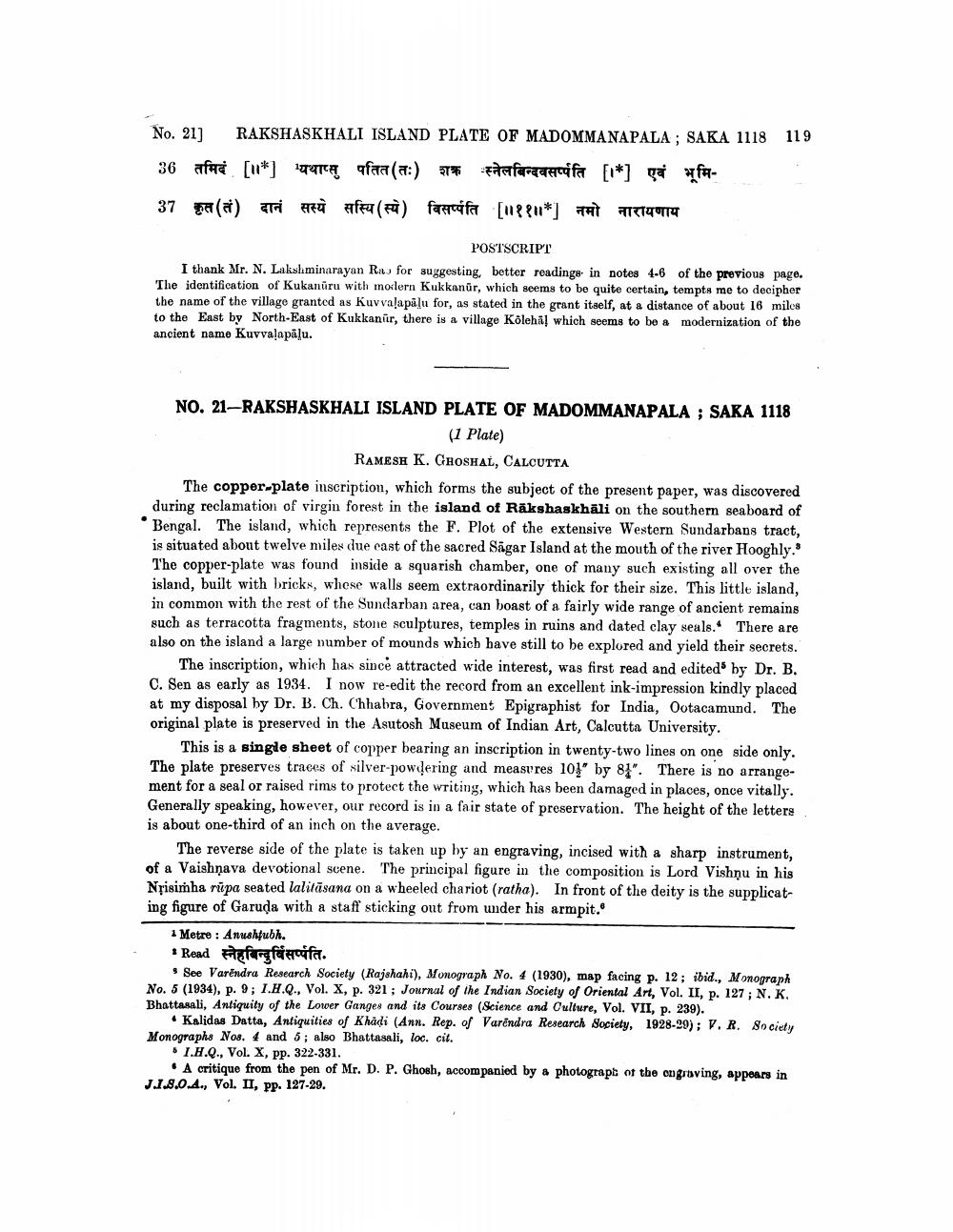________________
No. 21) 36 af
RAKSHASKHALI ISLAND PLATE OF MADOMMANAPALA ; SAKA 1118 119 [11*] TATÆ qaa(a) 7 aefareamhofer [1*] gai 4
37 gra (a)
Tit
af
) faufa [11881*]
paura
POSTSCRIPT I thank Mr. N. Lakshminarayan R for suggesting, better readinge in notes 4-6 of the previous page. The identification of Kukanūru with modern Kukkanūr, which seems to be quite certain, tempts me to decipher the name of the village granted as Kuvvalapāļu for, as stated in the grant itaelf, at a distance of about 16 miles to the East by North-East of Kukkanir, there is a village Kölehal which seems to be a modernization of the ancient name Kuvvaļapalu.
NO. 21-RAKSHASKHALI ISLAND PLATE OF MADOMMANAPALA ; SAKA 1118
(1 Plate) RAMESH K. GHOSHAL, CALCUTTA
The copper-plate inscription, which forms the subject of the present paper, was discovered during reclamation of virgin forest in the island of Rakshaskhāli on the southern seaboard of Bengal. The island, which represents the F. Plot of the extensive Western Sundarbans tract, is situated about twelve miles due cast of the sacred Sagar Island at the mouth of the river Hooghly. The copper-plate was found inside a squarish chamber, one of many such existing all over the island, built with bricks, whese walls seem extraordinarily thick for their size. This little island, in common with the rest of the Sundarban area, can boast of a fairly wide range of ancient remains such as terracotta fragments, stone sculptures, temples in ruins and dated clay seals. There are also on the island a large number of mounds which have still to be explored and yield their secrets.
The inscription, which has since attracted wide interest, was first read and edited by Dr. B. C. Sen as early as 1934. I now re-edit the record from an excellent ink-impression kindly placed at my disposal by Dr. B. Ch. Chhabra, Government Epigraphist for India, Ootacamund. The original plate is preserved in the Asutosh Museum of Indian Art, Calcutta University.
This is a single sheet of copper bearing an inscription in twenty-two lines on one side only. The plate preserves traces of silver-powdering and measures 101" by 81". There is no arrangement for a seal or raised rims to protect the writing, which has been damaged in places, once vitally. Generally speaking, however, our record is in a fair state of preservation. The height of the lettere is about one-third of an inch on the average.
The reverse side of the plate is taken up by an engraving, incised with a sharp instrument, of a Vaishnava devotional scene. The principal figure in the composition is Lord Vishnu in his Nrisimha rüpa seated lalitūsana on a wheeled chariot (ratha). In front of the deity is the supplicating figure of Garuda with a staff sticking out from under his armpit.
1 Metre : Anushfubh. * Read fargfaifa.
See Varēndra Research Society (Rajshahi), Monograph No. 4 (1930), map facing p. 12; ibid., Monograph No. 5 (1934), p. 9; 1.H.Q., Vol. X, p. 321 ; Journal of the Indian Society of Oriental Art, Vol. II, p. 127; N. K. Bhattasali, Antiquity of the Lower Ganges and its Courses (Science and Culture, Vol. VII, p. 239).
Kalidas Datta, Antiquities of Khadi (Ann. Rep. of Varendra Research Society, 1928-29); V. R. Society Monographs Nos. 4 and 5; also Bhattasali, loc. cit.
. 1.H.Q., Vol. X, pp. 322-331.
• A critique from the pen of Mr. D. P. Ghosh, accompanied by a photograph of the engraving, appears in J.1.8.0.A., Vol. II, pp. 127-29.




